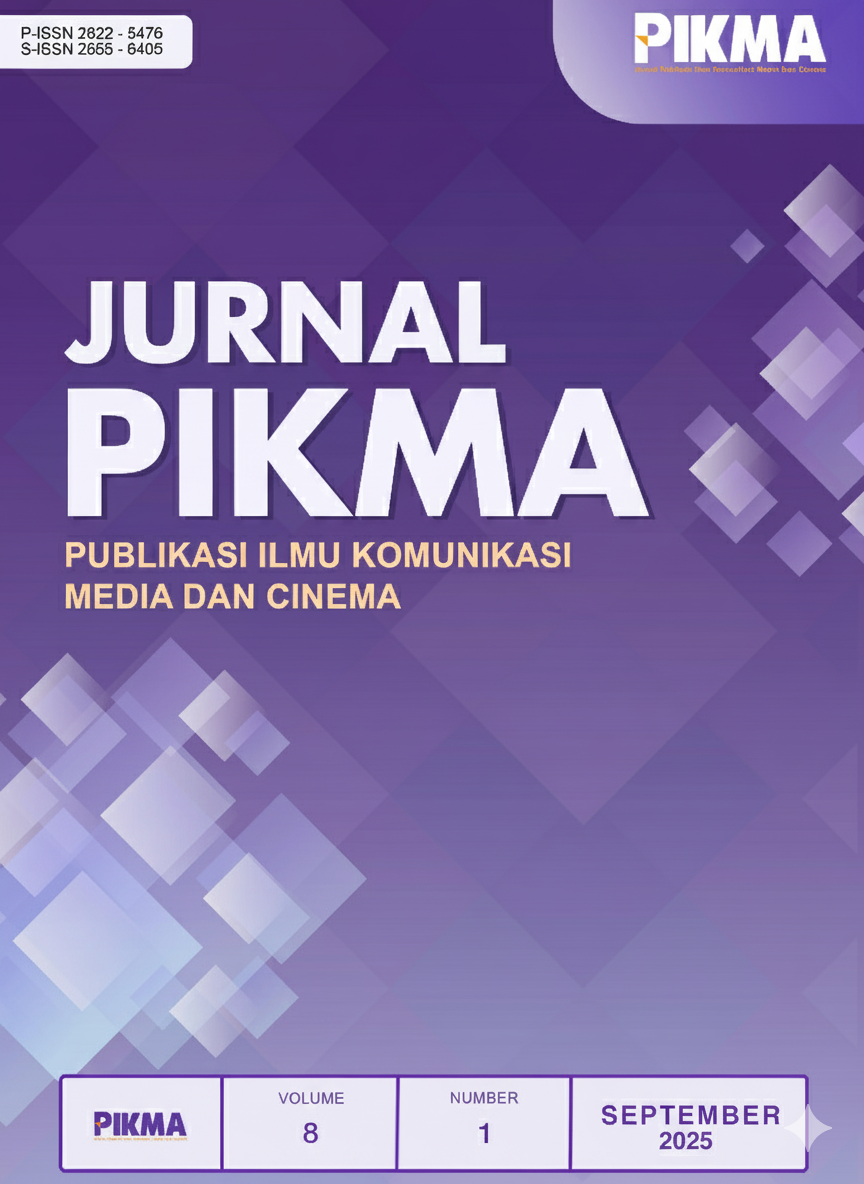Rainbows in Pixels: LGBTQ Representation on Animated Content in YouTube Kids
DOI:
https://doi.org/10.24076/771esg08Keywords:
Children media content, LGBTQ Representation, qualitative content analysis, youtube kidsAbstract
This study examines the representation of LGBTQ themes in children’s animated content on YouTube Kids, a widely accessed platform among children. In Indonesia, such content is controversial due to conflicting social norms. Using representation theory and qualitative content analysis, six animated videos were analyzed through visuals, dialogue, and narrative elements. The findings reveal both explicit and implicit portrayals of LGBTQ identities, including lesbian, gay, transgender, and queer, through human and anthropomorphic characters. These themes appear in various formats such as children’s series, music, and storytelling videos, often subtly embedded within broader narratives. The study concludes that while LGBTQ representation is generally subtle, it significantly contributes to shaping children's understanding of gender identity and sexuality. The research highlights the importance of balancing global inclusivity with sensitivity to local cultural values in media policy.
References
Aguiar, N. R., Richards, M. N., Bond, B. J., Putnam, M. M., & Calvert, S. L. (2019). Children’s parasocial breakups with media characters from the perspective of the parent. Imagination, Cognition and Personality, 38(3), 193–220. https://doi.org/10.1177/0276236618809902
Blue’s Clues & You! (Director). (2021, May 28). The Blue’s Clues Pride Parade Sing-Along Ft. Nina West! [YouTube video]. https://www.youtube.com/watch?v=d4vHegf3WPU
Caldwell, M. (2014). The occurrences, references and projected attitudes about LGBT lifestyles in children’s media: A content analysis of animated films [Honors Theses, Portland State University]. https://pdxscholar.library.pdx.edu/honorstheses/111
Candarli, D. (2023). YouTube for incidental vocabulary learning. In B. L. Reynolds (Ed.), Vocabulari learning in the wild (pp. 221–240). Springer Nature Singapore. https://doi.org/10.1007/978-981-99-1490-6_8
Capuzza, J. C. (2020). “T” is for “transgender”: An analysis of children’s picture books featuring transgender protagonists and narrators. Journal of Children and Media, 14(3), 324–342. https://doi.org/10.1080/17482798.2019.1705866
CNN Indonesia. (2019, February 13). Kominfo sebut konten LGBT langgar budaya Indonesia [Teknologi]. cnnindonesia.com. https://www.cnnindonesia.com/teknologi/20190213130810-192-368860/kominfo-sebut-konten-lgbt-langgar-budaya-indonesia
Cook, C. (2018). A content analysis of LGBT representation on broadcast and streaming television. Honors Theses. https://scholar.utc.edu/honors-theses/128
Creswell, J. W. (2013). Qualitative inquiry and research design: Choosing among five approaches (third edition). SAGE.
Creswell, J. W., & Creswell Báez, J. (2021). 30 essential skills for the qualitative researcher (Second edition). SAGE Publications, Inc.
Dennis, J. P. (2012). Gay content in newspaper comics. The Journal of American Culture, 35(4), 304–314. https://doi.org/10.1111/jacc.12001
Dewi, A. P. (2023, August 21). Pemerintah surati YouTube terkait kartun tak layak anak, berbau LGBT. Antara News. https://www.antaranews.com/berita/3690750/pemerintah-surati-youtube-terkait-kartun-tak-layak-anak-berbau-lgbt
Diamond, L. M. (2020). Gender fluidity and nonbinary gender identities among children and adolescents. Child Development Perspectives, 14(2), 110–115. https://doi.org/10.1111/cdep.12366
Dilley, P. (1999). Queer theory: Under construction. International Journal of Qualitative Studies in Education, 12(5), 457–472. https://doi.org/10.1080/095183999235890
Farnworth, A. E. (2022). LGBTQ+ representation in children’s television programming [Thesis]. California State University.
Farouk, Y. (2023, Agustus). Terungkap kartun berbahasa Indonesia kampanyekan LGBT, Netizen: Anak-anak cepat hafal. suara.com. https://www.suara.com/entertainment/2023/08/19/201630/terungkap-kartun-berbahasa-indonesia-kampanyekan-lgbt-netizen-anak-anak-cepat-hafal
Gecko’s Garage - Trucks For Children (Director). (2022, January 22). Truck Family Valentines Day | Gecko’s Garage | Trucks For Children | Cartoons For Kids [YouTube video]. https://www.youtube.com/watch?v=evW0jVhRhOc
Goodrich, K. M., Luke, M., & Smith, A. J. (2016). Queer humanism: Toward an epistemology of socially just, culturally responsive change. Journal of Humanistic Psychology, 56(6), 612–623. https://doi.org/10.1177/0022167816652534
Gultom, E. S., & Nuru, S. (2024). The portrait of LGBT practices in children animation. Southeast Journal of Language and Literary Studies, 4(1), 39–48. https://doi.org/10.53922/seshiski.v4i1.58
HaiBunda. (2023, February 11). Ramai tontonan YouTube Kids terpapar konten LGBT, Begini keresahan orang tua. parenting. https://www.haibunda.com/parenting/20230209162656-62-296871/ramai-tontonan-youtube-kids-terpapar-konten-lgbt-begini-keresahan-orang-tua
Hall, S. (1988). The rediscovery of ‘ideology’: Return of the repressed in media studies. In M. Gurevitch, T. Bennett, J. Curran, & J. Woollacott (Eds.), Culture, society, and the media (pp. 52–86). Routledge.
Hall, S. (1997). The local and the global: Globalization and ethnicity. In A. D. King (Ed.), Culture, globalization and the world system: Contemporary conditions for the representation of identity (pp. 19–40). University of Minnesota press.
Hall, S. (2005). New ethnicities. In S. Hall, D. Morley, & K.-H. Chen (Eds.), Stuart Hall: Critical dialogues in cultural studies (pp. 442–451). Routledge.
Hall, S. (2013). The work of representation. In S. Hall, J. Evans, & S. Nixon (Eds.), Representation (Second edition, pp. 1–59). Sage ; The Open University.
Hamlen, K. R., & Imbesi, K. J. (2020). Role models in the media: A content analysis of preschool television programs in the U.S. Journal of Children and Media, 14(3), 302–323. https://doi.org/10.1080/17482798.2019.1689369
Harman, S. (2016). Stuart Hall: Re-reading cultural identity, diaspora, and film. Howard Journal of Communications, 27(2), 112–129. https://doi.org/10.1080/10646175.2016.1148651
Hedberg, L., Venzo, P., & Young, H. (2022). Mums, dads and the kids: Representations of rainbow families in children’s picture books. Journal of LGBT Youth, 19(2), 198–216. https://doi.org/10.1080/19361653.2020.1779164
Hejazi, R. W. I. (2023). Animated movies with animals as major characters: A study of its impact on children aged 5-8 years. The Criterion: An International Journal in English, 14(4), 377–387.
Jacobs, L., & Meeusen, C. (2021). Coming out of the closet, also on the news? A longitudinal content analysis of patterns in visibility, tone and framing of LGBTs on television news (1986-2017). Journal of Homosexuality, 68(13), 2144–2168. https://doi.org/10.1080/00918369.2020.1733352
Jennings, T., & Macgillivray, I. K. (2011). A content analysis of lesbian, gay, bisexual, and transgender topics in multicultural education textbooks. Teaching Education, 22(1), 39–62. https://doi.org/10.1080/10476210.2010.538474
Jhally, S. (Director). (1997). Stuart Hall: Representation & the media [Video recording].
Krippendorff, K. (2019). Content analysis: An introduction to its methodology (Fourth edition). SAGE.
Kuckartz, U., & Rädiker, S. (2023). Qualitative content analysis: Methods, practice and software (2nd ed.). SAGE Publications.
Kusmanto, D. A., Prihatin, T., & Pranoto, Y. K. S. (2021). Early childhood language development of gadget users viewed from Behavioristic Theory. Journal of Primary Education, 10(1), 71–78. https://doi.org/10.15294/jpe.v10i1.45233
Larasati, I. (2023, September 27). Membentengi anak dari pornografi dan LGBT. Asihputera.Scd.Id. https://asihputera.sch.id/User/ContentDetail/membentengi-anak-dari-pornografi-dan-lgbt/1746
Leung, E., & Adams-Whittaker, J. (2022). Content analysis of LGBTQ picture books for elementary education through an intersectional lens. Frontiers in Education, 6(769769), 1–13. https://doi.org/10.3389/feduc.2021.769769
Little Baby Bum - Nursery Rhymes & Kids Songs (Director). (2020, January 28). Johny Johny Yes Papas Song | Lellobee—Nursery Rhymes for Kids | ABC & 123 [YouTube video]. https://www.youtube.com/watch?v=4Dw1M1afQDA
Mayring, P. (2000). Qualitative content analysis. Forum Qualitative Sozialforschung / Forum: Qualitative Social Research, 1(2). https://doi.org/10.17169/fqs-1.2.1089
Miles, M. B., Huberman, A. M., & Saldana, J. (2013). Qualitative data analysis: A methods sourcebook. SAGE Publications.
Miller, J. (2019). For the little queers: Imagining queerness in “new” queer children’s literature. Journal of Homosexuality, 66(12), 1645–1670. https://doi.org/10.1080/00918369.2018.1514204
Morgan, M., Shanahan, J., & Signorielli, N. (2014). Cultivation theory in the twenty-first century. In R. S. Fortner & M. Fackler (Eds.), The handbook of media and mass communication theory (pp. 480–497). Wiley-Blackwell.
Mursid, F., & Dwinanda, R. (2023, June 18). KPAI: Tidak ada ruang bagi LGBT, anak-anak harus dijauhkan dari perilaku menyimpang. Republika Online. https://republika.co.id/share/rwgbhx414
Netflix Jr. (Director). (2023, December 11). Family Time Fun! CoComelon Lane Singalong for Kids | Netflix Jr [YouTube video]. https://www.youtube.com/watch?v=dmNwKPRzyfM
Neumann, M. M., & Herodotou, C. (2020a). Evaluating YouTube videos for young children. Education and Information Technologies, 25(5), 4459–4475. https://doi.org/10.1007/s10639-020-10183-7
Neumann, M. M., & Herodotou, C. (2020b). Young children and YouTube: A global phenomenon. Childhood Education, 96(4), 72–77. https://doi.org/10.1080/00094056.2020.1796459
Peppa Pig - Official Channel (Director). (2023, June 18). Penny Polar Bear’s Mummies | Peppa Pig Official Full Episodes [YouTube video]. https://www.youtube.com/watch?v=WZFagRjAPOc
Pop’n’Olly (Director). (2015, November 29). Jamie—A Transgender Cinderella Story | Pop’n’Olly | Olly Pike [CC] [YouTube video]. https://www.youtube.com/watch?v=4_9F0RZUsIc
Pratnyawan, A. (2024, January 31). Anak-anak menghabiskan waktu lebih banyak di TikTok dibandingkan YouTube. suara.com. https://www.suara.com/tekno/2024/01/31/102928/anak-anak-menghabiskan-waktu-lebih-banyak-di-tiktok-dibandingkan-youtube
Qutub, A. A., & Muhammad, A. A. (2022). The effect of children’s exposure to the YouTube platform Moshaya Family Channel on socialization of the Saudi child regarding life satisfaction. Online Media and Global Communication, 1(2), 437–463. https://doi.org/10.1515/omgc-2022-0043
Rachman, F. (2022, Mei). Kaspersky: YouTube masih jadi aplikasi terpopuler anak Indonesia. validnews.com. https://validnews.id/kultura/kaspersky-youtube-masih-jadi-aplikasi-terpopuler-anak-indonesia
Razal, R. B. (2023). Pride branding: Brand, consumer, and authenticity perspectives [Dissertation]. Århus Universitet.
Riggs, D., & Treharne, G. (2017). Queer theory. In B. Gough (Ed.), The Palgrave handbook of critical social psychology (pp. 101–121). Palgrave Macmillan. https://doi.org/10.1057/978-1-137-51018-1_6
Ristiniemi, J., & Ahmadi, F. (2021). Where to and why? Children on meaning and value from a new materiality perspective. International Journal of Children’s Spirituality, 26(1–2), 44–66. https://doi.org/10.1080/1364436X.2020.1860913
Rohmiatun, I. (2024). Children’s addictive behavior in watching animation on YouTube, What is the solution? Journal of Business Social and Technology, 6(1), 1–9. https://doi.org/10.59261/jbt.v6i1.254
Sani, A. F. I. & Amirullah. (2018, January 25). Survei SMRC: 87,6 persen masyarakat menilai LGBT ancaman [Nasional]. Tempo. https://nasional.tempo.co/read/1053909/survei-smrc-876-persen-masyarakat-menilai-lgbt-ancaman
Sarwar, M. A., Ahmad, D., Kausar, S., & Tabassum, S. (2024). The diversity and inclusivity of content available on the YouTube Kids app: An analysis of different cultures languages and perspectives. Pakistan Journal of Law, Analysis and Wisdom, 3(2), 95–103.
Schaefer, I. (2023). Children’s television and its effects on LGBTQ youths’ identity milestones, acceptance, and comfort in identity. Journal of Student Research, 12(4), 1–16. https://doi.org/10.47611/jsrhs.v12i4.5212
Siddiqui, A. (2019). A critical look at YouTube videos: Causing behavioral change among children (SSRN Scholarly Paper 3453417). Social Science Research Network. https://doi.org/10.2139/ssrn.3453417
Snyder, A. L., Bonus, J. A., & Cingel, D. P. (2023). Representations of LGBQ+ families in young children’s media. Journal of Children and Media, 17(1), 154–160. https://doi.org/10.1080/17482798.2023.2173856
Tejomukti, R. A. (2023, August 27). MUI prihatinkan animasi anak memuat konten LGBT. Republika Online. https://republika.co.id/share/s00qka451
Van Wichelen, T., & Dhoest, A. (2023). Ticking off the (pink) diversity box? Production views on LGBT+ in children’s fiction. European Journal of Cultural Studies, 26(3), 371–387. https://doi.org/10.1177/13675494221116400
Van Wichelen, T., Dhoest, A., & De Ridder, S. (2024). Balancing boundaries: Mapping parents’ perceived concerns and opportunities of LGBTQ storylines in children’s television. Media, Culture & Society, 1–16. https://doi.org/10.1177/01634437241271012
Ward, L. M., & Grower, P. (2020). Media and the development of gender role stereotypes. Annual Review of Developmental Psychology, 2, 177–199. https://doi.org/10.1146/annurev-devpsych-051120-010630
Yadav, K., & Kalia, N. (2022). LGBT themes in children’s media and literature: Mirroring the contemporary culture and society. Rupkatha Journal on Interdisciplinary Studies in Humanities, 14(2), 1–10. https://doi.org/10.21659/rupkatha.v14n2.08
Downloads
Published
Issue
Section
License
Copyright (c) 2025 Jurnal PIKMA : Publikasi Ilmu Komunikasi Media Dan Cinema

This work is licensed under a Creative Commons Attribution-NonCommercial 4.0 International License.








